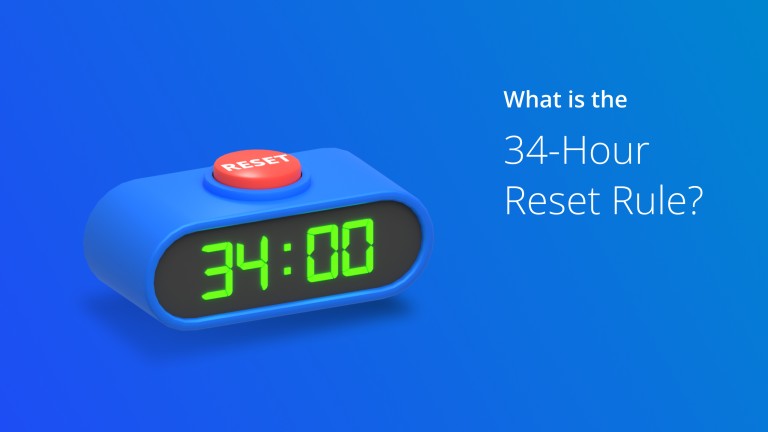Trucking companies are often involved in road collisions due to fatigued truck drivers. That is precisely why the Department of Transportation (DOT) limited driver working hours.
Under the Hours of Service regulations from the Federal Motor Carrier Safety Administration (FMCSA), the 34-hour reset rule is vital to ensure the safety of truck drivers.
So to help your fleet stay compliant with HOS regulations, read our in-depth guide about the 34-hour reset rule.
Table of Contents
What The 34-Hour Reset Rule Means
According to DOT, commercial motor vehicle drivers shouldn’t drive after 60/70 hours in 7/8 days continuously, but a driver can reset the 7/8 days workweek by taking 34 hours off duty.
Thus, the 34-hour reset rule allows drivers to restart the weekly working period if the maximum on-duty hours allowed are approaching.
A truck driver can reset the workweek by taking 34 consecutive hours off-duty time or sleeper berth.
Although it’s an arbitrary number, FMCSA Hours of Service rules state that 34 hours is sufficient for drivers to rest.
How Does It Work?
The 34-hour restart rule features Hours of Service status, including off-duty, on-duty, driving, and sleeper berth.
Truck drivers who are driving or on duty can work for 60 hours in seven days or 70 hours in eight days.
To take their 34-hour break, drivers should consume the hours continuously by going off duty or dividing the eight hours of sleeper berth time into two periods not lower than 2 hours.
After completing the 34-hour break, the driving cycle is reset. Then, drivers can resume working as a new cycle of the workweek begins.
Why Did The FMCSA Use 34 Hours?
FMCSA is a government agency mandated to regulate and ensure the safety of commercial motor vehicles. With that said, FMCSA found that the required driver rest should be 34 hours.
It’s the optimal time to prevent driver fatigue and promote full alertness to ensure safety.
In addition, considering the increasing driver fatigue-related fatalities, the 34-hour restart rule is a flexible time for drivers to take a break without compromising their health and operation.
Is The 34-Hour Reset Mandatory?
No, the 34-hour reset isn’t mandatory, but many drivers do it unknowingly. This rule isn’t required if your driver follows the rules 60/70 hours, 14 hours, and 11 hours.
It’s also an excellent strategy to monitor your drivers and prevent HOS rules violations.
Since there were over 5,000 large truck-related fatalities in 2019, allowing drivers to take a break can reduce this record.
Thus, the 34-hour reset benefits companies, drivers, and the general public.
When Can Drivers Use It?
The trucking industry has a common misconception that a driver can only take their 34-hour break at home under this provision.
On the contrary, drivers can take their breaks anywhere they find convenient, but they should log their breaks with the time zone of their home terminal.
For example, if drivers reach the driving or on-duty limit, they can immediately take a 34-hour rest to follow HOS regulations. A driver can take a rest during off-duty or in a sleeper berth.
How Do Drivers Log A 34-Hour Restart?
Implementing the 34-hour restart rule can be time-consuming for drivers and difficult to validate for companies if done through paper logs.
Thus, DOT and FMCSA have implemented the HOS rules of utilizing electronic logging devices (ELDs) to log a 34-hour restart efficiently.
Meanwhile, fleet businesses should partner with trusted service providers offering practical solutions to monitor driver statuses through real-time insights.
Trusted ELDs should offer real-time visibility, making it easier to plan routes and track the hours a driver works to prevent violations.
Provisions & Updates (2024)
In 2013, the 34-hour reset rule was passed into law as HOS regulations. However, it was suspended by Congress in the 2015 Omnibus Appropriations Bill.
The 2013 provisions were scrapped, including the rule that the 34-hour reset should have two different periods between 1:00 am and 5:00 am.
Furthermore, the second provision was removed, stating that the 34-hour reset is only available once every 168 hours, which DOT initially proposed into law.
Are There Exceptions To The Reset?
Yes, there are exceptions to this provision. For instance, short-haul drivers can log their hours through a time card if navigating within a 100-air-mile radius of their home terminal.
On the contrary, the log times won’t be affected for yard moves or trucking companies where drivers transfer their vehicles to another area in the job site.
Additionally, drivers utilizing company vehicles for personal use are logged as off-duty. Since personal time doesn’t apply to the 70-hour work period.
Can Route Planning Apps Enforce The 34-Hour Reset Rule?
Yes, route optimization software like Route4Me can enforce the 34-hour restart rule. Route4Me can assist businesses in tracking drivers and creating optimized routes for efficient operations.
In addition, drivers can easily log their status through their mobile phones, allowing managers to monitor their performance.
A route planner also has a centralized system, making monitoring drivers’ working hours easier and avoiding violating HOS provisions. Thus, it is a perfect tool for team and fleet management.
Multi-Stop Route Planner App

FAQs
How often can you do a 34-hour reset?
Since this provision is not mandatory, you can do the 34-hour reset anytime convenient, given you comply with the driving limit per work week.
Can you use personal conveyance during a 34-hour reset?
Yes, you can. Personal conveyance or personal use is allowed during the 34-hour reset as you’re logged by the company as off from work.
Is the 34-hour restart still in effect?
No, it’s no longer effective. In 2014, the suspended provisions were scrapped by FMCSA since studies concluded that it has no direct benefit on drivers’ safety, health, and fatigue.
In Summary
While FMCSA buried the 34-hour reset rule, this provision is certainly beneficial for drivers, allowing them to rejuvenate and perform better at work.
Also, this provision allows drivers to get adequate time to take a break and promotes safety on the road.
So if your team is utilizing this strategy, try Route4Me to implement the 34-hour restart rule easily.











